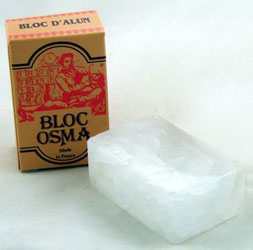Difference between revisions of "Alum"
(→Alum Block) |
|||
| Line 6: | Line 6: | ||
===Alum Block=== | ===Alum Block=== | ||
An alum block is used both to seal nicks and cuts, and as an after-shave treatment. The alum block is used by wetting it with cold water and rubbing it onto wet skin. | An alum block is used both to seal nicks and cuts, and as an after-shave treatment. The alum block is used by wetting it with cold water and rubbing it onto wet skin. | ||
| + | |||
For sealing a cut, simply dab the block on the cut and rub it around a bit. | For sealing a cut, simply dab the block on the cut and rub it around a bit. | ||
| + | |||
As an after-shave treatment, rub the block over the wet skin twice and allow the skin to dry by itself. Afterwards most razorburn and small nicks should be gone. | As an after-shave treatment, rub the block over the wet skin twice and allow the skin to dry by itself. Afterwards most razorburn and small nicks should be gone. | ||
Remember that using a alum block can sting quite a bit, but it's a quick-fading pain that doesn't take long to disappear. | Remember that using a alum block can sting quite a bit, but it's a quick-fading pain that doesn't take long to disappear. | ||
Revision as of 11:19, 23 January 2009
Alum is a form of crystal that's used for sealing shaving nicks and cuts. The two most common forms are the styptic pencil and the alum block.
Styptic Pencil
See Styptic Pencil
Alum Block
An alum block is used both to seal nicks and cuts, and as an after-shave treatment. The alum block is used by wetting it with cold water and rubbing it onto wet skin.
For sealing a cut, simply dab the block on the cut and rub it around a bit.
As an after-shave treatment, rub the block over the wet skin twice and allow the skin to dry by itself. Afterwards most razorburn and small nicks should be gone.
Remember that using a alum block can sting quite a bit, but it's a quick-fading pain that doesn't take long to disappear.
